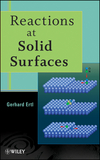
Reactions at Solid Surfaces
| List Price: | US $95.75 |
| Government Price: | US $65.88 |
Reactions at Solid Surfaces
Wiley is pleased to publish the authoritative introduction to surface reactions, by a renowned leader in the field. Reactions at Solid Surfaces provides a complete view of reactions at solid surfaces and of how chemistry works at surfaces, and shows how to understand and probe the dynamics of surface reactions.
Surface science is the study of the chemical and physical phenomena that occur at the interface of two phases. Although there are many related practical applications, the current focus in surface science centers around nanotechnology. It is at these smaller scales where the chemical and physical state of the surfaces becomes more important, and the field of surface science is thus critical for the development of nanotechnology.
Reactions at Solid Surfaces offers a broad view of surface reactivity, drawing on the author’s 30 years of expertise in the field. Professor Ertl includes examples from a variety of systems, comparing traditional surface probes with more modern probes, and bringing the various disciplines together in a cohesive manner.
This book originated with Professor Ertl’s lecture in the prestigious Baker Lecture series at Cornell University - the Baker Lecture is awarded to outstanding scientists at the peak of their professional distinction. While the books in the Baker Lecture series are based on the concept of the lectures given, they are authored in a way to teach individual students and professionals in a logical, pedagogical fashion, and are often used as the defining textbook in a particular field.
Reactions at Solid Surfaces is suitable as a graduate-level introductory textbook or as a self-teaching text, as well as a resource for researchers, students and professionals in the fields of surface science, chemical engineering, nanoscience, and nanotechnology.
CONTENTS
1. Basic principles
2. Surface structure and reactivity
3. Dynamics of molecule/surface interactions
4. Electronic excitations and surface chemistry
5. Principles of heterogeneous catalysis
6. Mechanisms of heterogeneous catalysis
7. Oscillatory kinetics and nonlinear dynamics
8. Spatiotemporal self-organization in surface reactions



